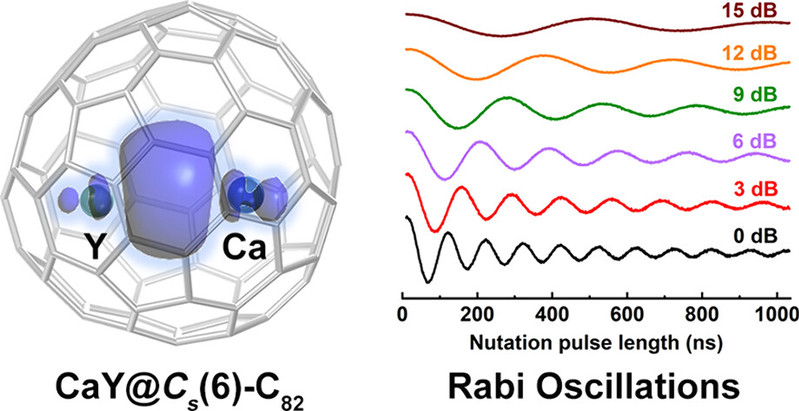CaY@C2n : Exploring Molecular Qubits with Ca-Y Metal-Metal Bonds
Jiawei Qiu1,2, Laura Abella3, Xiya Du4,5,6, Zhengkai Cao1,2, Zhiwen He1,2, Qingyu Meng1,2, Yingjing Yan1,2, Josep M. Poblet3, Lei Sun4,5,6,7(孙磊)*, Antonio Rodríguez-Fortea3*, Ning Chen1,2(谌宁)*
1College of Chemistry, Chemical Engineering, Soochow University, Suzhou,Jiangsu 215123, P.R. China
2Materials Science and State Key Laboratory of Radiation Medicine and Protection, Soochow University, Suzhou, Jiangsu 215123, P.R. China
3Departament de Química Física i Inorgànica,Universitat Rovira i Virgili, Tarragona 43007, Spain
4Department of Chemistry, School of Science and Research Center for Industries of the Future, WestlakeUniversity, Hangzhou, Zhejiang Province 310030, China
5Institute of Natural Sciences, Westlake Institute for Advanced Study, Hangzhou, Zhejiang Province 310024, China
6Department of Chemistry, School of Science and Research Center for Industries of the Future, Westlake University, Hangzhou, Zhejiang Province 310030, China;
7Key Laboratory for Quantum Materials of Zhejiang Province,Department of Physics, School of Science, Westlake University, Hangzhou, Zhejiang Province 310030, China
J. Am. Chem. Soc. 2024, 146, 35, 24310–24319
Abstract: Metal–metal bonding is crucial in chemistry for advancing our understanding of the fundamental aspects of chemical bonds. Metal–metal bonds based on alkaline-earth (Ae) elements, especially the heavier Ae elements (Ca, Sr, and Ba), are rarely reported due to their high electropositivity. Herein, we report two heteronuclear di-EMFs CaY@Cs(6)-C82 and CaY@C2v(5)-C80, which contain unprecedented single-electron Ca–Y metal–metal bonds. These compounds were characterized by single-crystal X-ray crystallography, electron paramagnetic resonance (EPR) spectroscopy, and DFT calculations. The crystallographic study of CaY@Cs(6)-C82 shows that Ca and Y are successfully encapsulated into the carbon cage with a Ca–Y distance of 3.691 Å. The CW-EPR study of both CaY@Cs(6)-C82 and CaY@C2v(5)-C80 exhibits a doublet, suggesting the presence of an unpaired electron located between Ca and Y. The combined experimental and theoretical results confirm the presence of a Ca–Y single-electron metal–metal bond with substantial covalent interaction, attributed to significant overlap between the 4s4p orbitals of Ca and the 5s5p4d orbitals of Y. Furthermore, pulse EPR spectroscopy was used to investigate the quantum coherence of the electron spin within this bond. The unpaired electron, characterized by its s orbital nature, is effectively protected by the carbon cage, resulting in efficient suppression of both spin–lattice relaxation and decoherence. CaY@Cs(6)-C82 behaves as an electron spin qubit, displaying a maximum decoherence time of 7.74 μs at 40 K. This study reveals an unprecedented Ae–rare-earth metal–metal bond stabilized by the fullerene cages and elucidates the molecular qubit properties stemming from their unique bonding character, highlighting their potential in quantum information processing applications.

链接://pubs.acs.org/doi/10.1021/jacs.4c04720